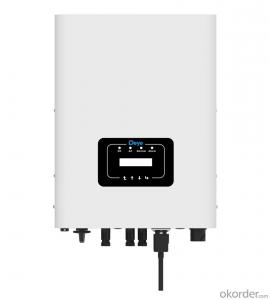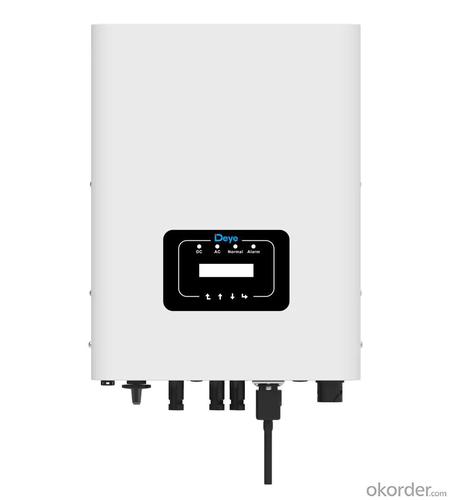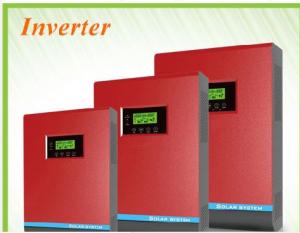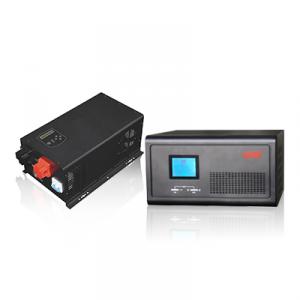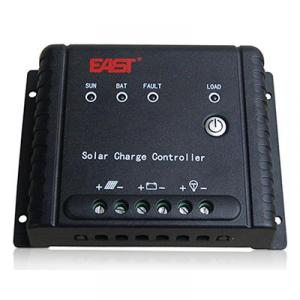SUN-15/17K-G03 15-17KW Three Phase 2 MPPT Higher yields
- Loading Port:
- Ningbo
- Payment Terms:
- TT OR LC
- Min Order Qty:
- 100 pc
- Supply Capability:
- 5000 pc/month
OKorder Service Pledge
OKorder Financial Service
You Might Also Like
Specification
2 MPP tracker, Max. efficiency up to 98.5%
Zero export application, VSG application
String intelligent monitoring (optional)
Wide output voltage range
Anti-PID function (Optional)
The series products adopt 2 MPP trackers design. Equipped with screw crimp terminal for DC and AC side, convenient installation and maintenance. With high detection accuracy, when the load power is less than 2%, the measurement accuracy is still high. In addition, it allows the system to be monitored and controlled remotely.
| Technical Data | ||||
| Model | SUN-15K-G05 | SUN-17K-G05 | ||
| Input Side | ||||
| Max. DC Input Power (kW) | 19.5 | 22.1 | ||
| Max. DC Input Voltage (V) | 1000 | |||
| Start-up DC Input Voltage (V) | 250 | |||
| MPPT Operating Range (V) | 200~850 | |||
| Max. DC Input Current (A) | 13+26 | |||
| Max. Short Circuit Current (A) | 19.5+39 | |||
| Number of MPPT / Strings per MPPT | 2/1+2 | |||
| Output Side | ||||
| Rated Output Power (kW) | 15 | 17 | ||
| Max. Active Power (kW) | 16.5 | 18.7 | ||
| Nominal Output Voltage / Range (V) | 3L/N/PE 380V/0.85Un-1.1Un, 400V/0.85Un-1.1Un | |||
| Rated Grid Frequency (Hz) | 50 / 60 (Optional) | |||
| Operating Phase | Three phase | |||
| Rated AC Grid Output Current (A) | 21.7 | 24.6 | ||
| Max. AC Output Current (A) | 23.9 | 27.1 | ||
| Output Power Factor | 0.8 leading to 0.8 lagging | |||
| Grid Current THD | <3% | |||
| DC Injection Current (mA) | <0.5% | |||
| Grid Frequency Range | 47~52 or 57~62 (Optional) | |||
| Efficiency | ||||
| Max. Efficiency | 98.5% | |||
| Euro Efficiency | 97.5% | |||
| MPPT Efficiency | >99% | |||
| Protection | ||||
| DC Reverse-Polarity Protection | Yes | |||
| AC Short Circuit Protection | Yes | |||
| AC Output Overcurrent Protection | Yes | |||
| Output Overvoltage Protection | Yes | |||
| Insulation Resistance Protection | Yes | |||
| Ground Fault Monitoring | Yes | |||
| Anti-islanding Protection | Yes | |||
| Temperature Protection | Yes | |||
| Integrated DC Switch | Yes | |||
| Remote software upload | Yes | |||
| Remote change of operating parameters | Yes | |||
| Surge protection | DC Type II / AC Type II | |||
| General Data | ||||
| Size (mm) | 333W×472H×202D | |||
| Weight (kg) | 15 | |||
| Topology | Transformerless | |||
| Internal Consumption | <1W (Night) | |||
| Running Temperature | -25~65℃, >45℃ derating | |||
| Ingress Protection | IP65 | |||
| Noise Emission (Typical) | <40 dB | |||
| Cooling Concept | Smart cooling | |||
| Max. Operating Altitude Without Derating | 2000m | |||
| Warranty | 5 years | |||
| Grid Connection Standard | CEI 0-21, VDE-AR-N 4105, NRS 097, IEC 62116, IEC 61727, G99, G98, VDE 0126-1-1, RD 1699, C10-11 | |||
| Operating Surroundings Humidity | 0-100% | |||
| Safety EMC / Standard | IEC/EN 61000-6-1/2/3/4, IEC/EN 62109-1, IEC/EN 62109-2 | |||
| Features | ||||
| DC Connection | MC-4 mateable | |||
| AC Connection | IP65 rated plug | |||
| Display | LCD1602 | |||
| Interface | RS485/RS232/Wifi/LAN | |||
- Q: Can a solar inverter be used with solar-powered streetlights?
- Yes, a solar inverter can be used with solar-powered streetlights. The solar inverter is responsible for converting the direct current (DC) produced by the solar panels into alternating current (AC) that can be used to power streetlights. This conversion allows the solar-powered streetlights to operate efficiently and effectively, utilizing the energy generated by the solar panels.
- Q: Can a solar inverter be used in a building-integrated photovoltaic system?
- Yes, a solar inverter can be used in a building-integrated photovoltaic system. A solar inverter is an essential component in any photovoltaic system as it converts the direct current (DC) produced by the solar panels into alternating current (AC) that can be used to power electrical devices in a building. In a building-integrated photovoltaic system, the solar panels are integrated into the building's structure, such as being incorporated into the roof or facade. The solar inverter is still required to convert the DC electricity generated by the integrated solar panels into AC electricity that can be used in the building.
- Q: Can a solar inverter be used in areas with high altitude and low temperature conditions?
- Yes, a solar inverter can be used in areas with high altitude and low temperature conditions. However, it is important to choose a solar inverter specifically designed for such conditions, as extreme cold temperatures and high altitudes can affect the performance and efficiency of standard inverters. Specialized inverters that can withstand low temperatures and operate at high altitudes are available in the market to ensure optimal functioning of solar power systems in such environments.
- Q: How does the input voltage rating affect the performance of a solar inverter?
- The input voltage rating is a critical factor in determining the performance of a solar inverter. The inverter's ability to convert the direct current (DC) generated by solar panels into alternating current (AC) for use in homes or businesses depends on the input voltage rating. If the input voltage rating of the inverter is not compatible with the voltage produced by the solar panels, the inverter may not function properly or may even be damaged. Thus, selecting an inverter with the correct input voltage rating is essential for optimal performance and longevity of a solar power system.
- Q: What is the role of a solar inverter in power quality management?
- The role of a solar inverter in power quality management is to convert the direct current (DC) generated by solar panels into alternating current (AC) suitable for use in the electrical grid. In addition to this primary function, solar inverters also play a crucial role in managing and maintaining power quality by ensuring a stable voltage and frequency output, reducing harmonics and reactive power, and providing grid support functions such as voltage regulation and power factor correction.
- Q: Can a solar inverter be used in areas with high levels of dust or pollution?
- Yes, solar inverters can be used in areas with high levels of dust or pollution. However, it is important to regularly clean and maintain the inverters to prevent the accumulation of dust or pollutants that could potentially impact their performance or lifespan.
- Q: How does a solar inverter protect against overvoltage or overcurrent?
- A solar inverter protects against overvoltage or overcurrent by constantly monitoring the electrical output from the solar panels. It uses built-in protection mechanisms such as surge protectors, voltage regulation circuits, and current limiters to prevent the voltage or current from exceeding safe levels. If an overvoltage or overcurrent event occurs, the inverter will automatically shut down or reduce the output to protect the system and connected devices from potential damage or failure.
- Q: How does the input power rating affect the performance of a solar inverter?
- The input power rating of a solar inverter directly affects its performance. A higher input power rating allows the inverter to handle a greater amount of solar energy, resulting in a higher energy conversion efficiency and overall performance. On the other hand, a lower input power rating may limit the inverter's capacity to handle larger solar systems, potentially leading to lower efficiency and reduced performance. Therefore, selecting an inverter with an appropriate input power rating is crucial to ensure optimal performance in a solar energy system.
- Q: Can a solar inverter be used with a smart home system?
- Yes, a solar inverter can be used with a smart home system. In fact, integrating a solar inverter with a smart home system allows for better monitoring, control, and optimization of the solar energy production and consumption in the home. This integration enables homeowners to track their energy usage, maximize self-consumption, and even automate certain appliances or systems based on the availability of solar power.
- Q: Can a solar inverter be used with a solar-powered refrigerator?
- Yes, a solar inverter can be used with a solar-powered refrigerator. The solar inverter is responsible for converting the direct current (DC) electricity generated by the solar panels into alternating current (AC) electricity, which is required to power the refrigerator. By using a solar inverter, the solar-powered refrigerator can operate efficiently and effectively by utilizing the solar energy collected from the panels.
Send your message to us
SUN-15/17K-G03 15-17KW Three Phase 2 MPPT Higher yields
- Loading Port:
- Ningbo
- Payment Terms:
- TT OR LC
- Min Order Qty:
- 100 pc
- Supply Capability:
- 5000 pc/month
OKorder Service Pledge
OKorder Financial Service
Similar products
Hot products
Hot Searches
Related keywords
